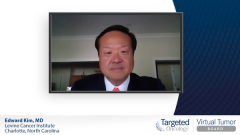
Case 1: Biomarkers in Small Cell Lung Cancer
Episodes in this series

Mark Socinski, MD: What about biomarkers in small cell lung cancer in terms of PD-L1? We hear a lot about TMB. Is it relevant in small cell? You did mention that it was certainly not a selection criterion for any of the small cell trials. But is it helpful?
Edward Kim, MD: If we were all in the room 5 years ago discussing this, we’d probably all vote for TMB knowing that in small cell, there’s a lot of noise and you would expect those patients who smoked to have more dirty tumors. However, if you believe either of those, we still struggle even in the non–small cell lung cancer realm with these biomarkers for immunotherapy. Maybe that will be different when we start looking at things like STK11 or keep with resistance certainly KRAS and others have shown some prediction. In small cell, as we pointed out, you don’t have to worry about testing right now. We don’t have a good marker, and neither of these markers have really shown any promise in helping to direct which patient population should be treated based on that.
Here is the new therapy biomarker. We can see on top that there’s a big question mark. IMpower133 didn’t really reveal anything. As you can see, there are some favorable aspects but nothing really predictive to see whether you’re looking at the blood-based tumor mutational burden or PD-L1 expression. Nothing really stands out as a true marker. Then there is overall survival based on the PD-L1 expression. It’s a little all over the place—nothing really pointed out that would lead us in a direction.
Certainly, from maintenance therapy there was really nothing that pointed out to us that by adding the nivolumab-ipilimumab in CheckMate 451. We think we know that maintenance can help, but not all the drugs necessarily translate to that. Even giving first-line chemotherapy and then having a maintenance strategy really didn’t reveal any predictive aspects to this treatment.
Mark Socinski, MD: Ed, let me ask you a little about that maintenance question. Were you surprised by that result that maintenance did not show something here? To be honest with you, I was surprised.
Edward Kim, MD: I was, part of what we believe in some of these currently approved trials is the fact that the maintenance approach afterward is what held the stability of disease or kept it at bay. It’s interesting. The more we study this I/O, even though we classified them as very similar from the beginning, they do behave differently in these trials. Some of it you think may be is random, but some of it also seems to be biology. Ipilimumab-nivolumab worked well in several tumor types, whereas tremelimumab did not work as well even in melanoma. Even from a setting of maintenance therapy, gosh, it would be interesting to see if it was given concurrently, for instance, with nivolumab in this trial, up front, and then had a doublet maintenance. That would be an interesting question to see. But maybe it was just bad luck, or maybe it really doesn’t work.
Transcript edited for clarity.










































